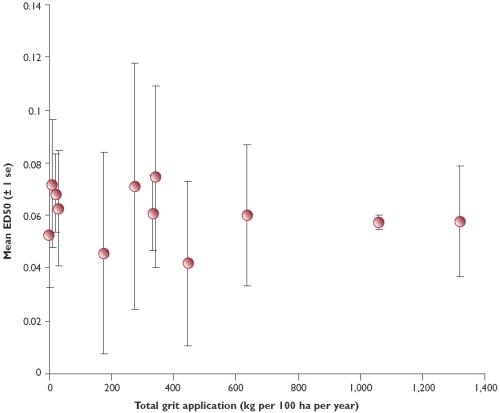Are parasites of red grouse becoming resistant?
Key findings
-
There is no evidence of resistance to fenbendazole in red grouse.
-
There is no relationship between the amount of the drug used and larval hatching success.
-
It is unclear whether resistance could build up in future.
-
We recommend taking steps to avoid resistance developing.
Red grouse populations in the UK show cyclic fluctuations with 'boom' and 'bust' years. The nematode worm, Trichostrongylus tenuis, a gut parasite causing strongylosis, drives these cycles through reducing grouse survival and breeding success. Crashes in grouse numbers following parasite increases can reduce income substantially on many upland estates and, over the last 15 years, medicated grit has been used to reduce worm burdens in red grouse. The active drug in medicated grit is fenbendazole, which kills the eggs and larvae of worms as well as the worms themselves. It reduces worm burdens in wild red grouse by about 40%, and improves grouse breeding success by increasing chick survival.
Many managers have become concerned that frequent use of a wormer may result in worms becoming resistant to the drug, hence lowering its effectiveness. This has been recorded in sheep and pigs with serious health, welfare and economic repercussions.
We investigated whether any resistance to fenbendazole has developed in strongyle worms in red grouse on 12 moors in northern England. Each moor differed in the amount and frequency of medicated grit provided. The amount of grit used ranged from 0 to 187 kilograms per square kilometre (100 hectares) per year. Length of treatment ranged from zero to seven years.
We assessed resistance of parasites on each moor using an egg-hatch assay, which tests whether a soluble form of the worming drug inhibits the hatching of freshly collected worm eggs. We extracted worm eggs from five samples of caecal faeces taken from each moor and incubated them in different concentrations of the drug for 48 hours. We calculated the proportion of eggs that failed to hatch and the concentration of drug that prevented 50% of eggs from hatching in each sample. This is called the 'ED50'.
Resistance to fenbendazole does not appear to have developed on any of the study sites. An ED50 value of more than 0.1 micrograms per millilitre indicates probable resistance, but the highest average value we found for any moor was only 0.074 micrograms per millilitre. Furthermore, the total amount of grit used on the moors did not significantly affect worm hatchability (see Figure 1) and there is no relationship between the amount of drug used and hatching success.
Figure 1: Comparison of the concentration of drug required to prevent 50% of the worm eggs hatching (ED50) and the total amount of medicated grit used

Currently, there is no evidence of drug resistance in strongyle worms in grouse in the UK. Whether resistance could develop in the future is determined by the extent that worms surviving the drug treatment contribute their genes to future generations. This is influenced by factors such as the nature of the drug, the parasite and the host-parasite system, including frequency and timing of treatment, the life-cycle of the parasite and the transmission of parasite to host. It is therefore difficult to say whether resistance to fenbendazole may ultimately develop in the future.
It is important that the effectiveness of currently available compounds is maintained. It is therefore worth considering strategies that could be employed to avoid resistance developing. For instance, it may help to combine the general use of medicated grit with the 'catch and treat' or dosing method using drugs such as Levamisole hydrochloride. Direct dosing would be most effective when high worm infection is expected, often in spring, whereas medicated grit could help to keep worm burdens at a low level.